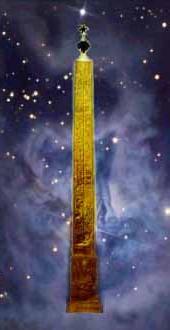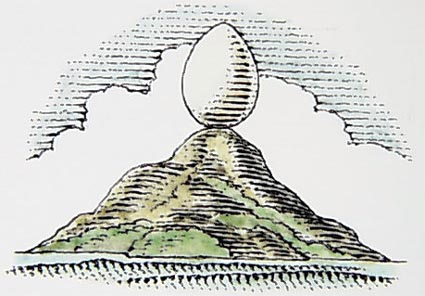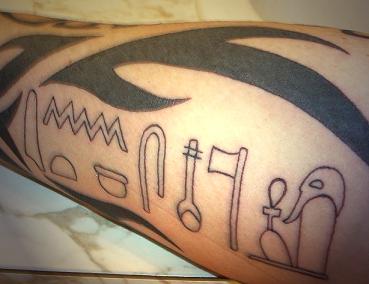
By Hernestus Gill
Priest of Antinous

By Hernestus Gill
Priest of Antinous

We are indebted to the OBELISK OF ANTINOUS for providing us with the only surviving rendering of the name of Antinous in Egyptian hieroglyphs. These glyphs, which have weathered the centuries, provide us with a tantalizing clue as to how the Ancients pronounced the name of Antinous.
The glyphs above are a rendering taken from the Sacred Obelisk. His name is spelled with these glyphs:
The Egyptians spelled it with a forearm ("A"), a wave of water ("N"), a hand ("D"), two reeds ("I") another "N", a water pot ("NU") and a bolt of folded cloth ("S"). The little triangles on either side of the "NU" pot are not standard glyphs and possibly only serve to balance the composition.
Also: an unvoiced "determinative" in the form of a human eye with highlighted upper lid. The most intriguing glyph is the eye with highlighted upper lid. It represents no spoken sound. It is a "determinative," which is to say it modifies or enhances the meaning of the name. Though experts are unclear about this glyph, it is usually interpreted as meaning "eye make-up," "eyelashes," "looking" or "good-looking." The name Antinous appears in three places on the Obelisk, and each time this mysterious eye glyph is in a different position in the name, but always near the start of the name.
Incidentally, no royal cartouche is used in his name. Only the names of pharaohs and caesars are written inside a cartouche. The names of gods stand alone — so Hadrian (a pharaoh) must be spelled with a cartouche, while Antinous (as a god) stands alone.
The name can also be spelled in a vertical format using another "S" glyph (the horizontal "door bolt"), depending on the scribe or artist's graphic art constraints.
Aside from the mysterious, unvoiced eyelid glyph, the most distinctive part of the name is the "NU" which is a biliteral glyph, which means it is two sounds "N" and "U" combined in one glyph. It's the only biliteral in the name. Biliterals always denote something special. The Egyptians usually didn't bother to try to show vowel sounds in names unless the vowel was particularly important. That is an indication that this particular "NU" sound was very important in pronouncing the name Antinous. The Egyptians heard a distinct "NU" sound in his name and felt it needed to be graphically represented.
It is important to remember that this Egyptian spelling represents a phonetic rendering of the name Antinous. As we know from modern languages, other people hear other sounds in a name. It was the same in Ancient times. Our transliteration from the ancient Greek is Antinoös, with an umlaut (two dots) over the second "o" to stress that there were four syllables (as far as certain Greeks were concerned). In other languages, of course, Antinous is spelled "Antinoo" or "Antinoos".

In English, we tend to pronounce his name "an-TIN-oh-us"
In most other languages, it is "ahn-TEE-no-uus", with an "oo" sound at the end as in "boo".
And in many languages, such as Spanish and Italian, his name is pronounced "an-ti-no-Oh".
Our own Flamen Antinoalis Antonyus Subia pronounces it "An-Ti-No-Us" (an-ti-no-oos) ... with equal emphasis on all syllables. He tends to blend the two final syllables together so that his actual pronunciation has become: "Anthee-No-woos".
Interestingly, the hieroglyphic inscription on the OBELISK OF ANTINOUS appears to back him up on his pronunciation. The Egyptians used a "D" to spell his name, perhaps indicating that the actual pronunciation was a very soft "T" somewhere between "T" and "D" — more like a "TH" in modern English.
We know from other inscriptions that the Egyptians were quite accurate in rendering "A-D-R-I-A-N-S" (Hadrianus) and the names of the other Caesars.
So these glyphs on the OBELISK OF ANTINOUS give us a tantalizing clue as to how his name may actually have been pronounced.
Did they really call him something that would sound like "Anthee-No-woos" to our modern-day ears? That's what the Obelisk inscription implies.
Each glyph was carefully chosen by the Priests of Antinous. On the Earthly Level, they wanted a phonetic match, of course. But on the Sacred Level they wanted a mystical match.
As Above, So Below.

The eye glyph (silent and unvoiced) may have been a "pun" on the Obelisk Text's reference Antinous being "Perfect in countenance, dazzling in beauty of the eyes ...."
Why did they use the "NU" glyph — the little round jar with a lid? They could have used an "N" and an "U" (quail chick glyph). Why ever did they use that "NU" glyph? Did that mean that the name "Antinous" was actually pronounced a special way? Did "Antinous" rhyme with "and he knew us"?
Or is there a more occult reason for using the "NU"
Perhaps the glyphs were a "Sacred Pun" on the story of the Rising Sun (the semi-circle) rising from the Primordial Ocean at "Sep Tepy" — the beginning of Time and Space.
The Constellation of Antinous is located right on the Celestial Equator and the Milky Way runs through it. The Constellation of Antinous is almost exactly over the "hub" of the Milky Way. When you look at the Constellation of Antinous, you are looking at the center of our home galaxy, which may explain why we see so many Super Novas there -- because we are looking at the center of the Milky Way galaxy.
In Ancient Egypt the Milky Way was considered to be the Celestial Nile. The River Nile was the earthly Water of Life to the Ancient Egyptians. Without the Nile there would have been no great Ancient Egyptian civilization. The Milky Way was their spiritual Water of Life.

The Milky Way represented the Waters of Life in which the Tree of Life had its roots.
They explained the origin of the universe in terms of a primordial ocean called Nun. It wasn't flat. Rather it was in the shape of a cosmic egg — and from this cosmic egg was born the primeval hill called "NU".
Of the Tree of Life (the Axis Munde) it is written: "I am the plant which comes from NU. My mother is Nut, Goddess of Heaven."
The goddess NUT — whose name is spelled with the "NU" glyph — was not exclusively female in gender. There are depictions of "her" as the male god Osiris — often sporting a raging phallic erection, as in the papyrus depicted here. This scene also shows NUT's consort, the Earth god GEB, in an act of auto-fellatio as the aroused Osiris/Nut arches over him with pregnant expectation.
As the god of death and transfiguration, Osiris is well-suited to play the role of Nut, who swallows the dying sun in the evening and gives birth to the newborn infant sun the next morning. Note the "elderly" Sun God between Osiris/Nut's legs waiting to be swallowed and reborn. Osiris himself died and rose again to become lord of eternal life.
The Egyptian gods are very gender-bending in that regard. Osiris in no way loses his masculinity by assuming the role of Nut, and apparently the Egyptians had no problem with the concept of a male deity giving birth ... whilst maintaining a rigid erection.

After all, that is why the Obelisk says Antinous can assume any form he wants, thanks to the "semen of the First God" which makes everything possible. One of those forms is Antinous-Osiris.
In religio-magical terms, Antinous can even be Osiris as the Sky Goddess Nut — with an erection. It says so on the Obelisk. He can take on any form his heart desires ....
Perhaps the Priests of Antinous intended for the spelling of HIS name to be an occult message telling us that Antinous rose out of the Nile, just as the sun rose out of the flat surface of the primordial ocean.
Or perhaps Antinous is the Sacred Mound, NU (also spelled with the NU glyph), rising out of the Waters of Nun: the Milky Way.
Antinous emerged from the depths of the Nile to become a god just as his Constellation emerges from the depths of the Milky Way.
All of that is incorporated into those five glyphs which were carefully chosen by the Ancient Priests of Antinous — and no doubt approved by the Divine Hadrian.
We can meditate for years to come (for the rest of our lives) on the secret and occult meanings of those Sacred Glyphs.